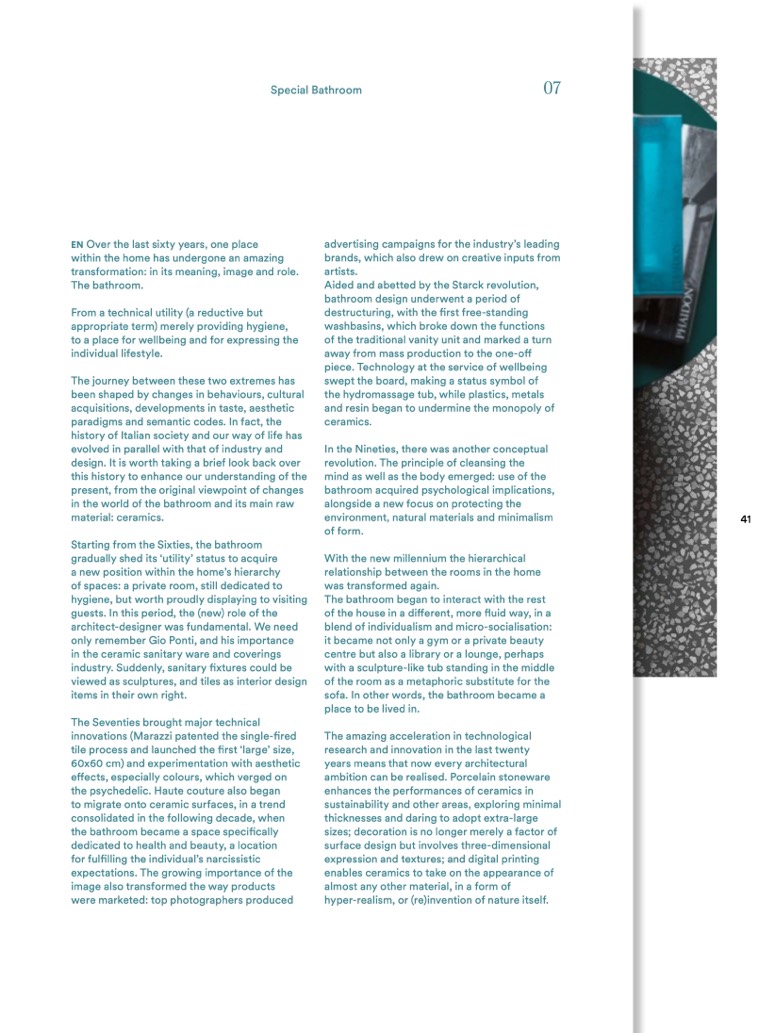
EN Over the last sixty years, one place
within the home has undergone an amazing
transformation: in its meaning, image and role.
The bathroom.
From a technical utility (a reductive but
appropriate term) merely providing hygiene,
to a place for wellbeing and for expressing the
individual lifestyle.
The journey between these two extremes has
been shaped by changes in behaviours, cultural
acquisitions, developments in taste, aesthetic
paradigms and semantic codes. In fact, the
history of Italian society and our way of life has
evolved in parallel with that of industry and
design. It is worth taking a brief look back over
this history to enhance our understanding of the
present, from the original viewpoint of changes
in the world of the bathroom and its main raw
material: ceramics.
Starting from the Sixties, the bathroom
gradually shed its ‘utility’ status to acquire
a new position within the home’s hierarchy
of spaces: a private room, still dedicated to
hygiene, but worth proudly displaying to visiting
guests. In this period, the (new) role of the
architect-designer was fundamental. We need
only remember Gio Ponti, and his importance
in the ceramic sanitary ware and coverings
industry. Suddenly, sanitary fixtures could be
viewed as sculptures, and tiles as interior design
items in their own right.
The Seventies brought major technical
innovations (Marazzi patented the single-fired
tile process and launched the first ‘large’ size,
60x60 cm) and experimentation with aesthetic
effects, especially colours, which verged on
the psychedelic. Haute couture also began
to migrate onto ceramic surfaces, in a trend
consolidated in the following decade, when
the bathroom became a space specifically
dedicated to health and beauty, a location
for fulfilling the individual’s narcissistic
expectations. The growing importance of the
image also transformed the way products
were marketed: top photographers produced
advertising campaigns for the industry’s leading
brands, which also drew on creative inputs from
artists.
Aided and abetted by the Starck revolution,
bathroom design underwent a period of
destructuring, with the first free-standing
washbasins, which broke down the functions
of the traditional vanity unit and marked a turn
away from mass production to the one-off
piece. Technology at the service of wellbeing
swept the board, making a status symbol of
the hydromassage tub, while plastics, metals
and resin began to undermine the monopoly of
ceramics.
In the Nineties, there was another conceptual
revolution. The principle of cleansing the
mind as well as the body emerged: use of the
bathroom acquired psychological implications,
alongside a new focus on protecting the
environment, natural materials and minimalism
of form.
With the new millennium the hierarchical
relationship between the rooms in the home
was transformed again.
The bathroom began to interact with the rest
of the house in a different, more fluid way, in a
blend of individualism and micro-socialisation:
it became not only a gym or a private beauty
centre but also a library or a lounge, perhaps
with a sculpture-like tub standing in the middle
of the room as a metaphoric substitute for the
sofa. In other words, the bathroom became a
place to be lived in.
The amazing acceleration in technological
research and innovation in the last twenty
years means that now every architectural
ambition can be realised. Porcelain stoneware
enhances the performances of ceramics in
sustainability and other areas, exploring minimal
thicknesses and daring to adopt extra-large
sizes; decoration is no longer merely a factor of
surface design but involves three-dimensional
expression and textures; and digital printing
enables ceramics to take on the appearance of
almost any other material, in a form of
hyper-realism, or (re)invention of nature itself.
Special Bathroom
07
M7GM Grande Marble Look Terrazzo Grey 160x320
471

